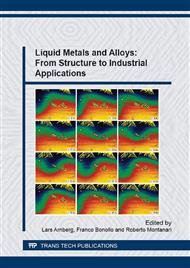[1]
A.R. Farkoosh, M. Javidani, M. Hosein, D. Larouch, M. Pekguleryuz, Phase formation in as-solidified and heat-treated Al–Si–Cu–Mg–Ni alloys: Thermodynamic assessment and experimental investigation for alloy design, J Alloys Compd. 551 (2013).
DOI: 10.1016/j.jallcom.2012.10.182
Google Scholar
[2]
A.R. Farkoosh, M. Pekguleryuz, Enhanced mechanical properties of an Al–Si–Cu–Mg alloy at 300°C: Effects of Mg and the Q-precipitate phase, Mater Sci Eng A. 621 (2015) 277-286.
DOI: 10.1016/j.msea.2014.10.080
Google Scholar
[3]
A.R. Farkoosh A, X. Chen, M. Pekguleryuz, The effects of Mg, Mo and Cr on the microstructure and elevated temperature mechanical properties of an Al-Si-Cu-Mg alloy, Mater Sci Technol. 2 (2013) 1220–1227.
Google Scholar
[4]
Q.G. Wang, D. Apelian, D.A. Lados, Fatigue behavior of A356/357 aluminum cast alloys. Part II - Effect of microstructural constituents, J Light Met. 1 (2001) 85–97.
DOI: 10.1016/s1471-5317(00)00009-2
Google Scholar
[5]
Q.G. Wang, D. Apelian, D.A. Lados, Fatigue behavior of A356-T6 aluminum cast alloys. Part I - Effect of casting defects, J Light Met. 1 (2001) 73-84.
DOI: 10.1016/s1471-5317(00)00008-0
Google Scholar
[6]
L. Ceschini, I. Boromei, A. Morri, S. Seifeddine, I.L. Svensson, Effect of Fe content and microstructural features on the tensile and fatigue properties of the Al–Si10–Cu2 alloy, Mater Des. 36 (2012) 522–528.
DOI: 10.1016/j.matdes.2011.11.047
Google Scholar
[7]
L. Ceschini, A. Morri, A. Morri, S. Toschi, S. Johansson, S. Seifeddine, Effect of microstructure and overaging on the tensile behavior at room and elevated temperature of C355-T6 cast aluminum alloy, Mater Des. 83 (2015) 626–634.
DOI: 10.1016/j.matdes.2015.06.031
Google Scholar
[8]
L. Ceschini, A. Morri, S. Toschi, S. Johansson, S. Seifeddine, Microstructural and mechanical properties characterization of heat treated and overaged cast A354 alloy with various SDAS at room and elevated temperature, Mater Sci Eng A. 648 (2015).
DOI: 10.1016/j.msea.2015.09.072
Google Scholar
[9]
L. Ceschini, A. Morri A, S. Toschi, Seifeddine S, Room and high temperature fatigue behaviour of the A354 and C355 (Al–Si–Cu–Mg) alloys: Role of microstructure and heat treatment, Mater Sci Eng A. 653 (2016) 129–138.
DOI: 10.1016/j.msea.2015.12.015
Google Scholar
[10]
S. Seifeddine, Characteristics of cast aluminium–silicon alloys: microstructures and mechanical properties. Linköping studies in science and technology: Dissertations, (2006).
Google Scholar
[11]
ASTM E3-01 Standard practice for preparation of metallographic specimens. ASM International (2007).
Google Scholar
[12]
ASTM ASTM E112-13 Standard Test Methods for Determining Average Grain Size. ASM International (2013).
Google Scholar
[13]
A. Rodríguez, R. Torres, J. Talamantes-Silva, E. Velasco, S. Valtierra, R. Colás, Metallographic study of a cast Al–Si–Cu alloy by means of a novel etchant, Mater Charact. 68 (2012) 110–116.
DOI: 10.1016/j.matchar.2012.03.012
Google Scholar
[14]
ASTM E 10-08 Standard test method for Brinell hardness of metallic materials. ASM International (2007).
Google Scholar
[15]
ISO 6892-1: 2009 Metallic materials - Tensile testing - Part 1: Method of test at room temperature (2009).
Google Scholar
[16]
ISO 6892-2: 2011, Metallic materials - Tensile testing - Part 2: Method of test at elevated temperature (2011).
Google Scholar
[17]
UNI 3964 – 85, Mechanical Testing of Metallic Materials Fatigue Testing at Room Temperature (1985).
Google Scholar
[18]
Y. Birol Y, Effect of silicon content in grain refining hypoeutectic Al–Si foundry alloys with boron and titanium additions, Mater Sci Technol. 28 (2012) 385–389.
DOI: 10.1179/1743284711y.0000000049
Google Scholar
[19]
J.A. Spittle, Grain refinement in shape casting of aluminium alloys, Int J Cast Met Res. 19 (2006) 210–222.
DOI: 10.1179/136404606225023444
Google Scholar
[20]
Y.C. Lee, A.K. Dahle, D.H. Stjohn, J.E.C. Hutt, The effect of grain refinement and silicon content on grain formation in hypoeutectic Al – Si alloys, Mat Sci Eng A. 259 (1999) 43–52.
DOI: 10.1016/s0921-5093(98)00884-3
Google Scholar
[21]
L. Ceschini L, I. Boromei, A. Morri, S. Seifeddine, I.L. Svensson, Microstructure, tensile and fatigue properties of the Al–10%Si–2%Cu alloy with different Fe and Mn content cast under controlled conditions, J Mater Process Technol. 209 (2009).
DOI: 10.1016/j.jmatprotec.2009.05.030
Google Scholar
[22]
Q.G. Wang, Microstructural Effects on the Tensile and Fracture Behavior of Aluminum Casting Alloys A356/357, Metall Mater Trans A. 34 (2003) 2887–2899.
DOI: 10.1007/s11661-003-0189-7
Google Scholar
[23]
E. Sjölander, S. Seifeddine, Optimization of Solution Treatment of Cast Al-7Si-0. 3Mg and Al-8Si-3Cu-0. 5Mg Alloys, Metall Mater Trans A. 45-4 (2014) 1916-(1927).
DOI: 10.1007/s11661-013-2141-9
Google Scholar
[24]
S. Seifeddine, S. Johansson, I.L. Svensson, The influence of cooling rate and manganese content on the β-Al5FeSi phase formation and mechanical properties of Al–Si-based alloys, Mater Sci Eng A. 490 (2008) 385–390.
DOI: 10.1016/j.msea.2008.01.056
Google Scholar
[25]
L. Ceschini, A. Morri, A. Morri, G. Pivetti, Predictive equations of the tensile properties based on alloy hardness and microstructure for an A356 gravity die cast cylinder head, Mater Des. 32 (2011) 1367–1375.
DOI: 10.1016/j.matdes.2010.09.014
Google Scholar
[26]
P. Rometsch, G. Schaffer, An age hardening model for Al–7Si–Mg casting alloys, Mater Sci Eng A. 325 (2002) 424–434.
DOI: 10.1016/s0921-5093(01)01479-4
Google Scholar
[27]
A.M. Samuel, F.H. Samuel, A metallographic study of porosity and fracture behavior in relation to the tensile properties in 319. 2 end chill castings, Metall Mater Trans A. 26 (1995) 2359–2372.
DOI: 10.1007/bf02671250
Google Scholar
[28]
M. Tiryakioglu, J. Campbell, J. Staley, The influence of structural integrity on the tensile deformation of cast Al–7wt. %Si–0. 6wt. %Mg alloys, Scr Mater. 49 (2003) 873–878.
DOI: 10.1016/s1359-6462(03)00439-1
Google Scholar
[29]
Z. Li, Q. Wang, A.A. Luo, P. Fu, L. Peng, Fatigue strength dependence on the ultimate tensile strength and hardness in magnesium alloys, Int J Fatigue. 80 (2015) 468–76.
DOI: 10.1016/j.ijfatigue.2015.07.001
Google Scholar
[30]
D.L. Shu, The mechanical properties of engineering materials. Beijing: China machine Press (2007).
Google Scholar


